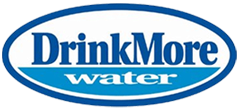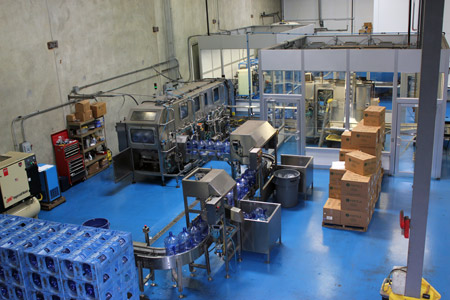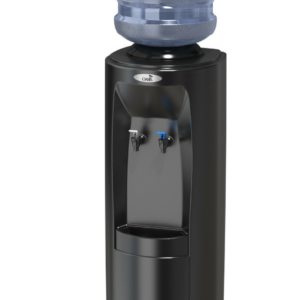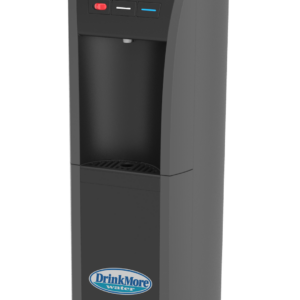Purification Technology
DrinkMore Water is very distinct from ordinary spring and mineral waters because of the custom-engineered system we use to purify the water. This unique system, available for your inspection at our state-of-the-art bottling facility, incorporates twelve steps to ensure DrinkMore Water’s absolute purity.
Following is a detailed description of each of the steps in our purification process. While this material is fairly technical, this piece is intended for a general audience. Those readers with additional questions about DrinkMore Water’s technology may directly contact the engineer who designed the system (who also happens to be our founder!), Bob Perini.
1. Sediment Filtration
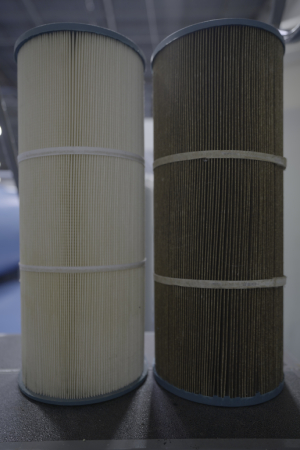 Our complex purification process begins with a simple, pleated-paper sediment filter. This filter traps relatively large particles which may be present in the water-things like dirt, sand, slime and grit. Take a look at the difference between dirty filters and brand new filters. Obviously, it’s necessary to start our purification process with this basic step in order to remove these large particles which could foul or clog the more sensitive equipment used in later stages.
Our complex purification process begins with a simple, pleated-paper sediment filter. This filter traps relatively large particles which may be present in the water-things like dirt, sand, slime and grit. Take a look at the difference between dirty filters and brand new filters. Obviously, it’s necessary to start our purification process with this basic step in order to remove these large particles which could foul or clog the more sensitive equipment used in later stages.
We us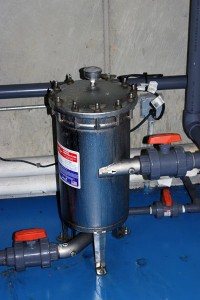 e a Harmsco Hurricane filter for our sediment filtration and the cartridges are rated at 10 microns (a micron is one-millionth of a meter, or 1/25,000th of an inch.) How small is that? Well, the human eye can only see particles 20 microns in diameter or larger. You’d be very surprised at what we see when we change these filters. We monitor the pressure drop across the filter for purposes of determining when the filter is clogging. There have been times when construction in the area has forced us to change out the filters as frequently as every thirty minutes!
e a Harmsco Hurricane filter for our sediment filtration and the cartridges are rated at 10 microns (a micron is one-millionth of a meter, or 1/25,000th of an inch.) How small is that? Well, the human eye can only see particles 20 microns in diameter or larger. You’d be very surprised at what we see when we change these filters. We monitor the pressure drop across the filter for purposes of determining when the filter is clogging. There have been times when construction in the area has forced us to change out the filters as frequently as every thirty minutes!
2. Ion Exchange
The next step in our purification process is the removal of various metallic elements through a process known as ion exchange. Sometimes referred to as water “softening,” ion exchange utilizes a large tank which is filled with a special, negatively-charged resin. The resin beads serve as bases or sites for the ion exchange to actually take place.
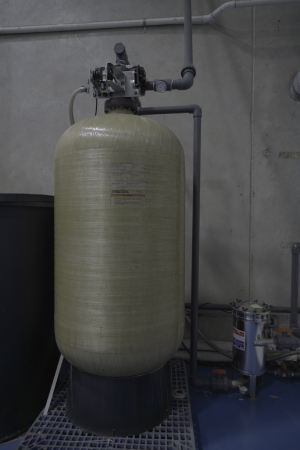 As water passes through the ion exchange resin, metallic ions, which carry a strong positive charge, displace the more weakly charged sodium and potassium ions. The metallic ions are thus trapped via electromagnetic attraction to the resin particles. The ion exchange beds are then automatically cleansed and regenerated at prescribed intervals based on water volume. The regeneration process involves flooding the bed with a super saturated saline solution that effectively sweeps away the metallic ions from the resin sites.
As water passes through the ion exchange resin, metallic ions, which carry a strong positive charge, displace the more weakly charged sodium and potassium ions. The metallic ions are thus trapped via electromagnetic attraction to the resin particles. The ion exchange beds are then automatically cleansed and regenerated at prescribed intervals based on water volume. The regeneration process involves flooding the bed with a super saturated saline solution that effectively sweeps away the metallic ions from the resin sites.
Ion exchange provides highly effective removal of the metals responsible for pipe scaling and deposits. The process also removes various heavy metals, such as lead, mercury, iron, and cadmium, which have been associated with well-publicized health concerns.
From DrinkMore Water’s perspective, it is important to remove metals early in the purification process to protect the more sensitive technology used in later steps, since high levels of metals can damage this equipment.
3. Activated Carbon Towers
Once the water passes through the ion exchange system, it moves into over-sized granular activated carbon beds. Carbon filtration (also known as charcoal filtration), which utilizes a process known as adsorption, is a particularly effective technique for chlorine removal. Pesticides, herbicides, and other organic contaminants (especially volatile organics) are also removed at this stage.
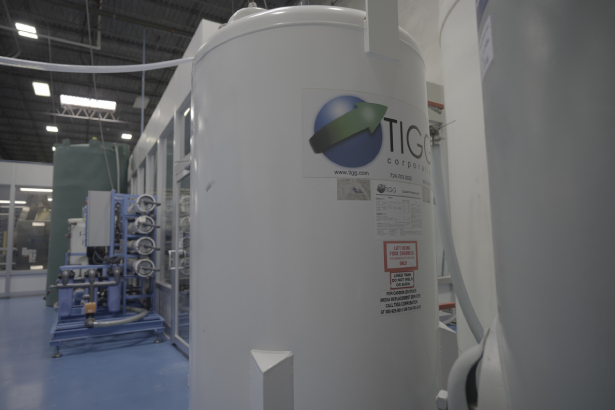
Carbon also does an excellent job of removing trihalomethanes (THMs) from the water. THMs are a class of chlorinated chemicals which result from the interaction of chlorine and decaying organic matter in the public water supply. These chemicals are known carcinogens, and the high levels found in local water supplies have been a cause for concern in recent years.Our Carbon Adsorption Towers are in series – meaning water has to pass through both towers before moving on to the next step. We routinely change out all of the carbon in each of the tanks on an annual basis.
Many will recognize the term “granular activated carbon” as it is the most common technology used in home filter systems, refrigerator filters and ice maker filters. The technology is designed primarily to remove the chlorine taste found in tap water. Unfortunately, these home systems are often poorly maintained and neglected. They will work for a while but then what happens next can be kinda scary. If the filter isn’t changed at the appropriate interval, the effectiveness of the chlorine removal will decrease and, in some cases, the contaminants in an over-loaded filter actually begin to discharge back into the water. That’s not good. And furthermore, there have been numerous instances of bacterial contamination associated with poorly maintained home filter systems. Once the chlorine is gone – there’s the risk of bacteriological growth downstream of the filter.
At DrinkMore Water, our carbon filters are routinely backwashed to prevent channeling and the carbon is completely replaced every year. Maintenance and filter replacements are carried out by trained engineers in accordance with a predetermined schedules.
4. Ultraviolet Light #1
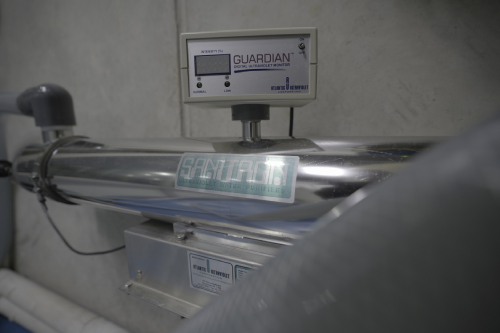 Since the DrinkMore Water process removes all chlorine from the water, two forms of chemical-free disinfection technology are employed to ensure that the purified water remains absolutely and completely free from any sort of microbiological contamination. Ultraviolet disinfection is the first of these technologies.
Since the DrinkMore Water process removes all chlorine from the water, two forms of chemical-free disinfection technology are employed to ensure that the purified water remains absolutely and completely free from any sort of microbiological contamination. Ultraviolet disinfection is the first of these technologies.
At this step in the process, the water passes through a special chamber which houses a large ultraviolet light source. This ultraviolet light acts as a powerful sterilizing agent. If any bacteria, viruses, or other microbiological contaminants are present in the water, the ultraviolet light at this particular wavelength destroys the genetic material within these organisms, eliminating the possibility of bacterial or viral reproduction and proliferation. The organisms quickly die and are captured and removed during the prefiltering before the reverse osmosis purification process.
Our process has extensive control technologies throughout. For example, over time the effficacy of the ultraviolet lamp gradually deteriorates. We have a UV lamp monitoring device which measures the intensity of the actual UV lamp. When the bulb is new (it’s changed every year), the monitor reads 100% – meaning that’s the baseline. When the monitor declines to 95%, an alarm will sound indicating that the bulb needs replacement.
5. One Micron Pre-Filter
Once through the ultraviolet light, our water then passes through another set of absolute filters – these being of the 1-Micron pore size – meaning that nothing larger than 1 Micron will pass through. So, if anything is killed by the ultraviolet light, it would be picked up by the absolute filters. A 1 Micron filter is capable of removing viruses, bacteria, cryptosporidium and various other deleterious bugs.
6 (and 7). Two Passes of Reverse Osmosis
The picture below shows the centerpiece of our purification system – reverse osmosis technology. This unit cranks out about 60 gallons per minute of the purest, sweetest-tasting water on the planet earth. It utilizes a 20 HP Pump that sounds like a jet engine. And please, take note of the clean-room in which it sits. Yes, you could eat off the floor!
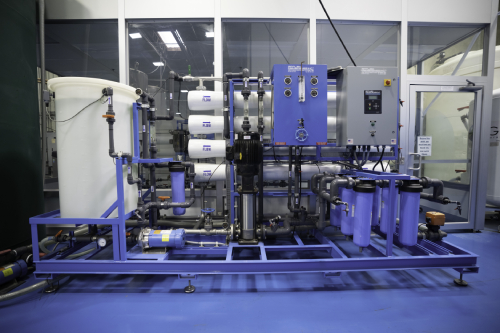
Reverse osmosis truly is the heart of the DrinkMore Water purification process. Many people have heard about the process of osmosis. Osmosis is a naturally occurring process whereby water passes across a membrane due to a pressure differential between one side of the membrane and the other.
As osmosis takes place, the concentration of dissolved material on each side of the membrane moves closer to an equilibrium state. That is, the more concentrated solution will tend to become more diluted, and the more diluted solution will tend to become more concentrated. Many people are familiar with osmosis as the process by which living cells receive nutrients and excrete wastes.
In reverse osmosis, high pressure is used to force water across a membrane while impurities are left behind. In other words, the high pressure causes the impurities to become more concentrated on one side of the membrane. Only the pure water is able to cross the membrane; even the dissolved impurities which cannot be removed by conventional filtration are captured and eliminated by DrinkMore Water’s reverse osmosis purification system.
The reverse osmosis system featured at DrinkMore Water utilizes state-of-the-art technology for both purified water production and quality control. Every drop of our purified water must pass through approximately twenty layers of reverse osmosis membranes – that’s how 99.5% of the dissolved impurities actually get removed.
If even a slight variation in quality occurs, an alarm is triggered and the entire system shuts down – and you’ll appreciate this – that alarm has never sounded in the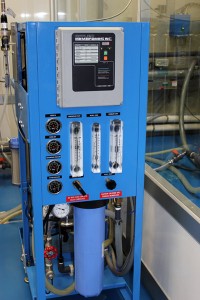 8 years we’ve been purifying and bottling water in our new facility. The result is a purity level that’s second to none. In fact, we encourage you to compare our water with any other water-spring water, mineral water, or filtered water.
8 years we’ve been purifying and bottling water in our new facility. The result is a purity level that’s second to none. In fact, we encourage you to compare our water with any other water-spring water, mineral water, or filtered water.
We recently purchased a second entire reverse osmosis unit for purposes of handling our concentrate water. We run that water through a second RO unit and recover another 25% of the water – meaning that we now have a recovery close to 90% – which is extremely efficient and just another of our efforts to be as green as we can possibly be.
8. Ozonation
The most important part of our chemical-free disinfection is known as ozonation. Ozonation relies on oxygen to ensure that our purified water remains free of any possible microbiological contamination.
The ozonation process takes basic molecular oxygen (O2) and passes it through a special chamber in which it is exposed to a high voltage electrical charge. (This type of ozone generation is called cold-plasma discharge.) The electricity causes the oxygen molecule to split and recombine in a higher-energy form known as ozone (O3). This ozone is then continuously circulated through the purified water.
DrinkMore utilizes ozone at several steps in our process. We begin introducing ozone right at the exit of our reverse osmosis unit. The purpose is to keep every single part of our system – 100% sanitary and bacteria free. We employ sanitizing technologies that very few companies could compete with. And we employ MORE of that technology than practically any competitor.
9. More Ultraviolet Light
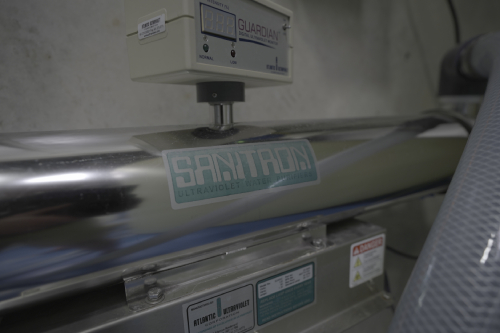
No, we’re not done yet. We have yet another ultraviolet light that the water must pass through before reaching our stainless steel storage tanks.
Same technology as described above – just another step in the overall journey of the water becoming DrinkMore Water.
10. More Ozonation
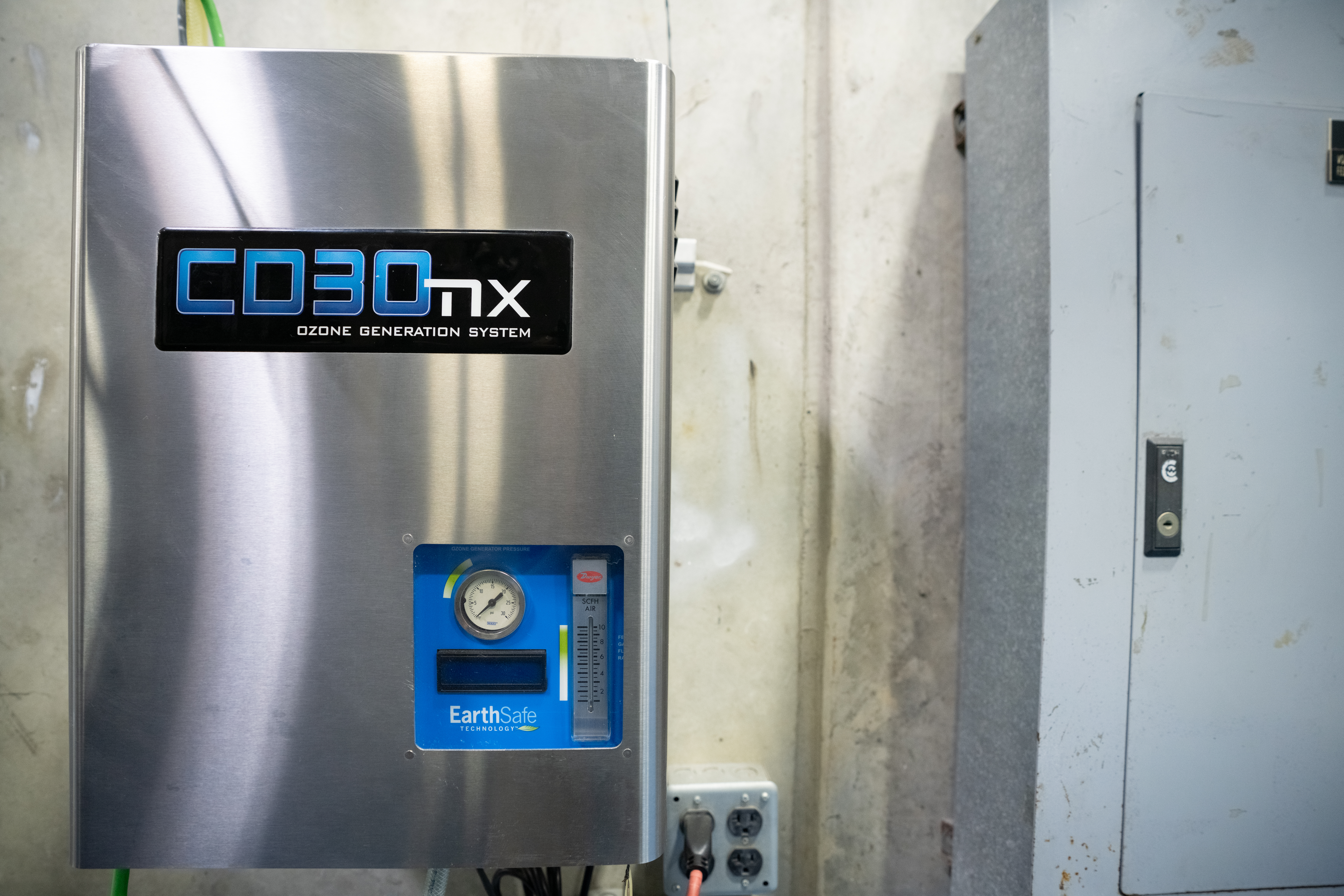
We spoke briefly about the benefits of ozone sanitization. Ozone is a very powerful disinfectant and is capable of oxidizing a very broad range of contaminants. In fact, ozone is highly effective against many types of impurities and organisms, such as cryptosporidium, that are utterly impervious to chlorination. Just how powerful is ozone? First of all, it’s about 1,500 times more effective than chlorine as an oxidant.
In real life, ozone is very effective at killing cryptosporidium. Tests have shown that at normal concentration levels (1 part per million), ozone will destroy 99.99% of cryptosporidium oocysts given five minutes of contact time. Chlorine, however, doesn’t affect cryptosporidium oocyst viability at concentrations of 30,000 parts per million for a period of eighteen hours. The standard concentration of chlorine in tap water is around 3 parts per million-imagine what 30,000 parts per million would taste like!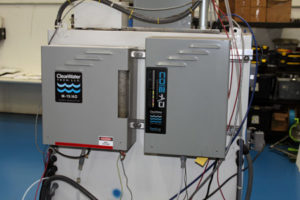
Ozone is not a stable state for oxygen, and over the course of a few minutes it returns to its natural O2 state. This state-of-the-art disinfection system is simple, yet extremely powerful. And best of all, it relies on nothing more than all-natural oxygen-absolutely no strange chemicals or additives.
So, where does all of this ozonation take place? In our finished product storage tanks.
11. Storage, Ozonation & Recirculation
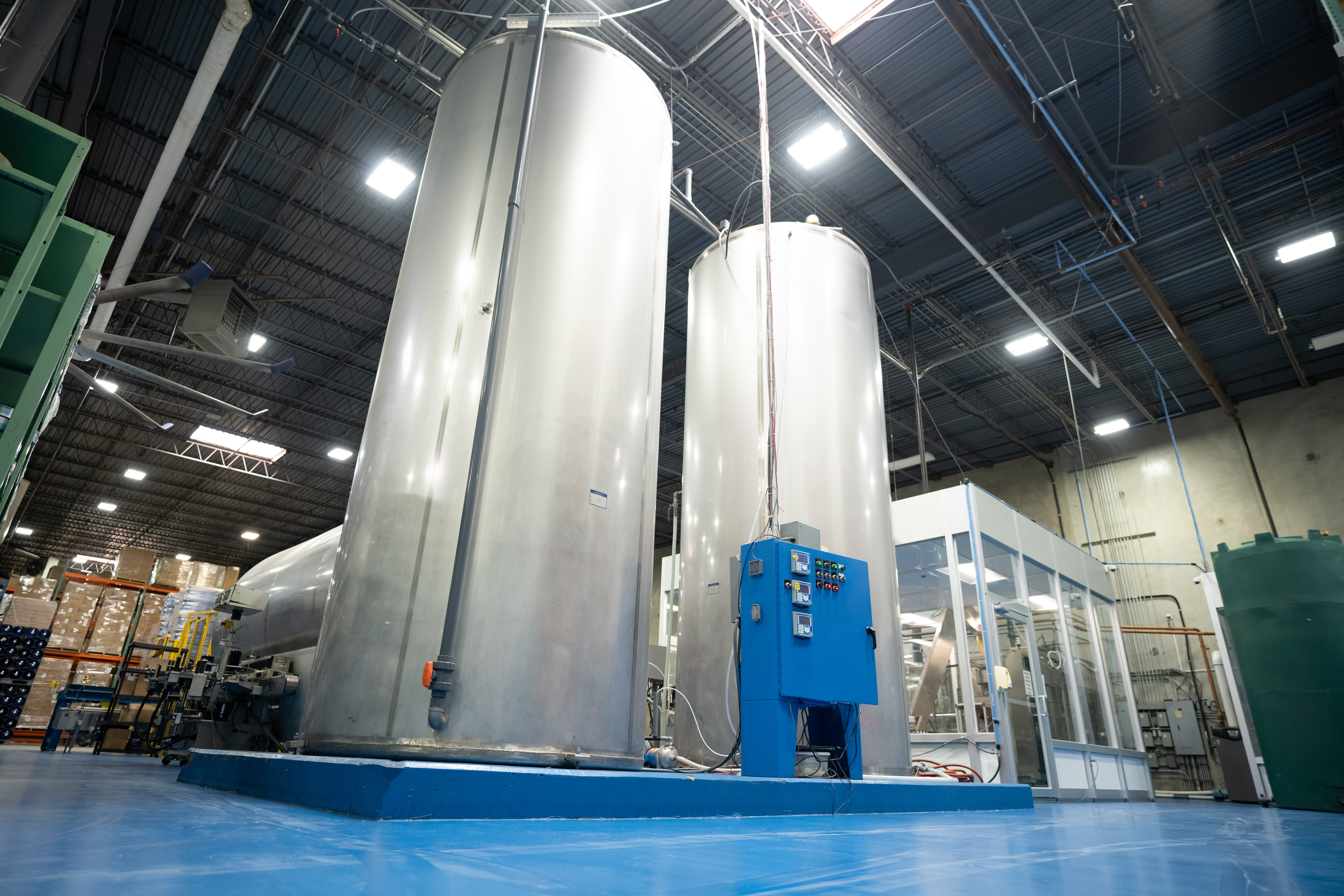
After the water has passed through the preceding ten steps it moves into the storage and recirculation phase. This storage and recirculation system has been designed so that DrinkMore Water will retain its exceptionally high purity and will not come into contact with any materials or substances which could in any way compromise the quality of the water. DrinkMore Water features a storage system made entirely of stainless steel. Many people are unaware that brass, a key component of many plumbing systems, can be a primary source of lead contamination. By using only stainless steel, this problem, and the problem of potential interactions with other substances, is completely avoided.
Our storage tanks are stainless and our pumps are stainless. But DrinkMore Water does not simply sit in storage after purification. Instead, the water continuously travels through a recirculation loop. During recirculation, additional ozone is periodically added to maintain the completely sterile and bacteria-free condition of the system. The entire system is controlled by probably the most sophisticated analyzer and controller technology on the market today.
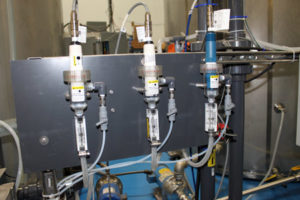 These little babies are flow cells which continually sample our storage tanks on a 24/7 basis. Inside these flow cells are sensors which monitor and control different variables like ozone concentration, PH, conductivity, etc. The sensors feed the data to our analyzer panel where the data is displayed and recorded again on a 24-7 basis.
These little babies are flow cells which continually sample our storage tanks on a 24/7 basis. Inside these flow cells are sensors which monitor and control different variables like ozone concentration, PH, conductivity, etc. The sensors feed the data to our analyzer panel where the data is displayed and recorded again on a 24-7 basis.
12. Bottling Process
When a bottle is filled at DrinkMore Water, the water is drawn directly from the continuous recirculation loop and fed to our bottling system. Like the water storage system, our water dispensers utilize stainless steel on all water contact surfaces. But our bottling process is so cool that we have a whole other section dedicated to showing you just how that process works!! Make sure you check that out here.
